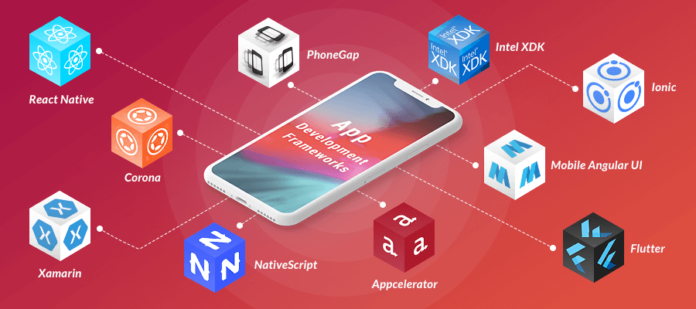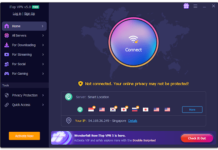Wondering what mobile development framework to use for your new app? We’ve rounded up the top seven so you can make a decision and get started hiring developers or building it yourself.
What Is a Mobile Development Framework?
A framework is simply a toolset for making mobile apps. Most businesses find it helpful to interact with their market through a mobile app since there are a lot of benefits. Having an app gets your business name right onto a customer’s phone. It allows you to potentially send notifications to your customer, helping you stay connected and engaged. Finally, and most importantly, it helps you deliver a superior customer experience, which is, fundamentally, what makes the difference between a good and a great business.
Two Types of Mobile-Development Frameworks
Basically, there are two types of frameworks. First, there are native frameworks. Some users have iPhones, and you can make an iPhone-specific app using the iOS native development framework. Some users have an Android, and there’s a native Android framework. You get the idea.
Native frameworks work really well with phone hardware. It’s a lot like Apple’s Facetime: Facetime is so hard to beat in terms of quality because its hardware and software are perfectly synchronized. Trying to make a video chat app for multiple platforms makes such synchronicity very difficult. So native frameworks can be really helpful in solving such kind of challenges.
At the same time, native frameworks have a major pitfall: cost. If half of your customers use one device and half use another, you would need two different mobile apps! That means twice the development cost, twice the hours, twice the customer support, and twice the security updates to roll out on a regular basis.
To make up for this weakness, the second type of framework, the cross-platform framework, is not tied to any particular device, brand, or hardware/software configuration. Cross-platform frameworks work on virtually any device because they leverage software that is general to the internet. For this reason, they tend to be much more flexible (though in some ways less precise and powerful than their native counterparts), and some of them are even open source (meaning they are free, and anyone is free to submit updates to the software whenever they find problems).
Also Read: How to Choose the Right Tech Stack for Mobile App Development?
Without further ado, let’s jump into the comparison.
Comparison of Top Mobile-Development Frameworks
In this comparison, I’ll mention some of the key features of each of the top-seven frameworks. There’s no simple one-to-one comparison since each framework is suited to different use-cases, but this brief overview can help you make a decision about where to start looking for your next app project.
Ionic
Ionic (also known as Ionic Framework 5, with the original being released in 2013), is an open-source framework built on AngularJS. That means it is a JavaScript-based framework, which is good news, because JavaScript powers most of the internet. Ionic is cross-platform compatible. It is used to produce HTML5 apps (almost like websites on your phone) and is known for creating highly interactive app experiences.
Recently, Ionic has also added official React integrations. On their site, they explain,
Ionic React is an open source UI and Native API project consisting of cross-platform UI components and native functionality for building iOS, Android, Electron and Progressive Web Apps using React and standard web technology.
Ionic React is the official React version of the popular Ionic Framework, used by millions of web developers and powering mission critical apps for companies like Amtrak, AAA, Burger King, Home Depot, and more. (Source)
This makes Ionic even better than ever, and it’s almost certainly a viable, powerful, and free solution for your app.
React Native
React Native (released in 2015) has rapidly launched to prominence. Users love React apps because they are so smooth and often give the illusion of being even faster than they are. One of React Native’s claims to fame is its asynchronous way of updating each piece of the app (called components). It makes the experience smooth, and even with slow loading speed, these apps look and feel great. Developers love React, too, because it makes for a smooth development experience. After all, it was created to speed up app development at Facebook. Like its web counterpart, React Native apps are written using JavaScript and JSX (any developer who is familiar with JavaScript will find JSX quite simple to grasp).
React Native is a great framework if you want to maximize your user experience since it specializes in only updating things that need to be updated, and doing so in a way that doesn’t disrupt what the user sees when looking at the app interface.
Also Read: How to Monetize Your Mobile App: Smart Tactics for Successful Startup
Flutter
Flutter’s goal is to make it easier for you to create faster, more beautiful, and mobile-, web-, and desktop-targeted apps. It makes these things possible through a number of key features. First, it has a “hot reload” feature which means developers can see changes in live time, making development milliseconds fast. Second, it uses a layered architecture. What this means is that everything loads fast and feels seamless. Background layers and foreground features interact perfectly, and nothing feels out of place. Finally, Flutter uses native compiling, so that your app works like it was built on a native framework, whether on Android or iPhone.
In short, Flutter is a powerful, Google-backed development framework that will get your app from idea to launch faster than you thought possible. Oh, and it’s also free and open source.
jQuery Mobile
The jQuery mobile framework is an excellent option, even though it may not sound as trendy as the others. Its claim to fame is the ability to create one single codebase that gives you a “single, highly-branded responsive web site or application that will work on all popular smartphone, tablet, and desktop platforms”.
If you want a lean, highly branded mobile app, and you want a mature codebase that is not based on the latest trend (the jQuery project started back in 2005), jQuery Mobile might be the right fit for you.
Xamarin
If it seems to you like every framework is backed by a major corporation who heads up its development and support, then you won’t be surprised to hear that Microsoft owns the popular Xamarin framework.
In short, Xamarin’s major benefit is that it allows .NET developers to use familiar tools to launch mobile apps. It creates compiled apps, so your user gets a super-fast, lean experience. If your developers are .NET people, or they love using Visual Studio Code, then Xamarin may be the best option for you.
PhoneGap / Apache Cordova
PhoneGap bridges a gap between the world of the internet with websites and web-apps, and the world of the mobile device, which often involves device-specific coding frameworks. Purchased by Adobe and later released as the open-source library Apache Cordova, this framework makes it possible to deliver powerful and user-friendly mobile apps with only the tools of the web.
If you’re a web developer and want to make a mobile app, or you don’t have the budget to hire a separate app-development firm, this may be the option for you. Apache Cordova uses HTML5, JavaScript, and CSS3—standard web tools. If you need to launch your app on every platform, and you need it done yesterday, then this is also a very good option for you.
Appcelerator
Appcelerator offers the ability to create a single JavaScript codebase and compile your apps natively for any device. It gives you direct access to platform-native code, as well, through its Hyperloop tool. One of its most outstanding features is its powerful analytics. Your users may not know or care what mobile-development framework lies behind your app, but with Appcerlator you will know how they are interacting with your app and brand. A business can only act on the information it knows, after all.
If you want a drag-and-drop development experience coupled with powerful analytics and a cross-platform codebase, then Appcelerator may be the right platform for you.
Conclusion
One thing you notice about each of these frameworks is that they emphasize speed, code reusability across platforms and devices, and the development and user experiences.
At the end of the day, having an app in any framework is better than paralysis from agonizing over which mobile-development framework to use. My suggestion? Work with developers you like, and let them worry about the code. They will use the tools they know best or have recommended to them. Each of these options is a good one, and your customers are waiting for your app, so don’t disappoint them!
Also Read: The Connection Between Green Cloud Computing and Mobile Cloud Computing











